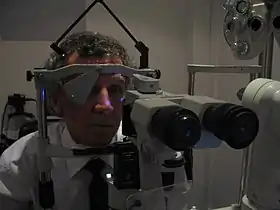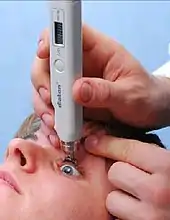Intraocular pressure
Intraocular pressure (IOP) is the fluid pressure inside the eye. Tonometry is the method eye care professionals use to determine this. IOP is an important aspect in the evaluation of patients at risk of glaucoma.[1] Most tonometers are calibrated to measure pressure in millimeters of mercury (mmHg).

Physiology
Intraocular pressure is determined by the production and drainage of aqueous humour by the ciliary body and its drainage via the trabecular meshwork and uveoscleral outflow. The reason for this is because the vitreous humour in the posterior segment has a relatively fixed volume and thus does not affect intraocular pressure regulation.
An important quantitative relationship (Goldmann's equation) is as follows:[2]
Where:
- is the IOP in millimeters of mercury (mmHg)
- the rate of aqueous humour formation in microliters per minute (μL/min)
- the resorption of aqueous humour through the uveoscleral route (μL/min)
- is the facility of outflow in microliters per minute per millimeter of mercury (μL/min/mmHg)
- the episcleral venous pressure in millimeters of mercury (mmHg).
The above factors are those that drive IOP.
Measurement

Palpation is one of the oldest, simplest, and least expensive methods for approximate IOP measurement.[3] Intraocular pressure is measured with a tonometer as part of a comprehensive eye examination.
Measured values of intraocular pressure are influenced by corneal thickness and rigidity.[4][5] As a result, some forms of refractive surgery (such as photorefractive keratectomy) can cause traditional intraocular pressure measurements to appear normal when in fact the pressure may be abnormally high. A newer transpalpebral and transscleral tonometry method is not influenced by corneal biomechanics and does not need to be adjusted for corneal irregularities as measurement is done over upper eyelid and sclera.[6]
Classification
Current consensus among ophthalmologists and optometrists defines normal intraocular pressure as that between 10 mmHg and 20 mmHg.[7][8][9][10] The average value of intraocular pressure is 15.5 mmHg with fluctuations of about 2.75 mmHg.[11]
Ocular hypertension (OHT) is defined by intraocular pressure being higher than normal, in the absence of optic nerve damage or visual field loss.[12][13]
Ocular hypotension, hypotony, or ocular hypotony, is typically defined as intraocular pressure equal to or less than 5 mmHg.[14][15] Such low intraocular pressure could indicate fluid leakage and deflation of the eyeball.
Influencing factors
Daily variation
Intraocular pressure varies throughout the night and day. The diurnal variation for normal eyes is between 3 and 6 mmHg and the variation may increase in glaucomatous eyes. During the night, intraocular pressure may not decrease[16] despite the slower production of aqueous humour.[17] Glaucoma patients' 24-hour IOP profiles may differ from those of healthy individuals.[18]
Fitness and exercise
There is some inconclusive research that indicates that exercise could possibly affect IOP (some positively and some negatively).[19][20][12]
Musical instruments
Playing some musical wind instruments has been linked to increases in intraocular pressure. A 2011 study focused on brass and woodwind instruments observed "temporary and sometimes dramatic elevations and fluctuations in IOP".[21] Another study found that the magnitude of increase in intraocular pressure correlates with the intraoral resistance associated with the instrument, and linked intermittent elevation of intraocular pressure from playing high-resistance wind instruments to incidence of visual field loss.[22] The range of intraoral pressure involved in various classes of ethnic wind instruments, such as Native American flutes, has been shown to be generally lower than Western classical wind instruments.[23]
Drugs
Intraocular pressure also varies with a number of other factors such as heart rate, respiration, fluid intake, systemic medication and topical drugs. Alcohol and marijuana consumption leads to a transient decrease in intraocular pressure and caffeine may increase intraocular pressure.[24]
Taken orally, glycerol (often mixed with fruit juice to reduce its sweet taste) can cause a rapid, temporary decrease in intraocular pressure. This can be a useful initial emergency treatment of severely elevated pressure.[25]
The depolarising muscle relaxant succinylcholine, which is used in anaesthesia, transiently increases IOP by around 10 mmHg for a few minutes. This is significant for example if the patient requires anaesthesia for a trauma and has sustained an eye (globe) perforation. The mechanism is not clear but it is thought to involve contraction of tonic myofibrils and transient dilation of choroidal blood vessels. Ketamine also increases IOP.[26][27]
Significance
Ocular hypertension is the most important risk factor for glaucoma.
Intraocular pressure has been measured as a reviewedary outcome in a systematic review comparing the effect of neuroprotective agents in slowing the progression of open angle glaucoma.[28]
Differences in pressure between the two eyes are often clinically significant, and potentially associated with certain types of glaucoma, as well as iritis or retinal detachment.
Intraocular pressure may become elevated due to anatomical problems, inflammation of the eye, genetic factors, or as a side-effect from medication. Intraocular pressure laws follow fundamentally from physics. Any kinds of intraocular surgery should be done by considering the intraocular pressure fluctuation. Sudden increase of intraocular pressure can lead to intraocular micro barotrauma and cause ischemic effects and mechanical stress to retinal nerve fiber layer. Sudden intraocular pressure drop can lead to intraocular decompression that generates micro bubbles that potentially cause multiple micro emboli and leading to hypoxia, ischemia and retinal micro structure damage.[29]
References
- Farandos, Nicholas M.; Yetisen, Ali K.; Monteiro, Michael J.; Lowe, Christopher R.; Yun, Seok Hyun (April 2015). "Contact lens sensors in ocular diagnostics". Advanced Healthcare Materials. 4 (6): 792–810. doi:10.1002/adhm.201400504. PMID 25400274. S2CID 35508652.
- Aptel F, Weinreb RN, Chiquet C, Mansouri K (November 2016). "24-h monitoring devices and nyctohemeral rhythms of intraocular pressure". Prog Retin Eye Res. 55: 108–148. doi:10.1016/j.preteyeres.2016.07.002. PMID 27477112. S2CID 24677841.
- Heidary, Fatemeh; Gharebaghi, Reza; Heidary, Roghayeh (30 July 2010). "Palpation by blind examiners: A novel approach for glaucoma screening". Clinical Ophthalmology. 4: 671–672. doi:10.2147/opth.s11167. ISSN 1177-5483. PMC 2915851. PMID 20689781.
- Grieshaber MC, Schoetzau A, Zawinka C, Flammer J, Orgul S (June 2007). "Effect of central corneal thickness on dynamic contour tonometry and Goldmann applanation tonometry in primary open-angle glaucoma". Arch. Ophthalmol. 125 (6): 740–4. doi:10.1001/archopht.125.6.740. PMID 17562982.
- Tanaka GH (April 1998). "Corneal pachymetry: a prerequisite for applanation tonometry?". Arch. Ophthalmol. 116 (4): 544–5. PMID 9565063.
- Cacho I, Sanchez-Naves J, Batres L, Pintor J, Carracedo G (2015). "Comparison of Intraocular Pressure before and after Laser In Situ Keratomileusis Refractive Surgery Measured with Perkins Tonometry, Noncontact Tonometry, and Transpalpebral Tonometry". J Ophthalmol. 2015: 683895. doi:10.1155/2015/683895. PMC 4475733. PMID 26167293.
- webMD - Tonometry
- Glaucoma Overview Archived 4 July 2008 at the Wayback Machine from eMedicine
- Hashemi H, Kashi AH, Fotouhi A, Mohammad K (June 2005). "Distribution of intraocular pressure in healthy Iranian individuals: the Tehran Eye Study". Br J Ophthalmol. 89 (6): 652–7. doi:10.1136/bjo.2004.058057. PMC 1772663. PMID 15923494.
- Pooranee (9 October 2015). "Do you know about Intra Ocular Pressure?". Health Education Bureau, Information and Communication Technology Agency, Sri Lanka. Retrieved 4 November 2015.
- Janunts E. "Optical remote sensing of intraocular pressure by an implantable nanostructured array". Medizinische Fakultät der Universität des Saarlandes. Archived from the original on 25 April 2012.
- Vieira GM, Oliveira HB, de Andrade DT, Bottaro M, Ritch R (September 2006). "Intraocular pressure variation during weight lifting". Arch. Ophthalmol. 124 (9): 1251–4. doi:10.1001/archopht.124.9.1251. PMID 16966619.
- Ocular Hypertension, American Optometric Association. Accessed 2015-11-3.
- "Ocular Hypotony: Background, Pathophysiology, Epidemiology". Medscape Reference. 5 February 2014. Retrieved 4 November 2015.
- Henderer JD, Budenz DL, Flynn HW, Schiffman JC, Feuer WJ, Murray TG (February 1999). "Elevated intraocular pressure and hypotony following silicone oil retinal tamponade for complex retinal detachment: incidence and risk factors". Arch. Ophthalmol. 117 (2): 189–95. doi:10.1001/archopht.117.2.189. PMID 10037563.
- Liu JH, Weinreb RN (May 2011). "Monitoring intraocular pressure for 24 h". Br J Ophthalmol. 95 (5): 599–600. doi:10.1136/bjo.2010.199737. PMID 21330554. S2CID 42736853.
- Brubaker RF (1991). "Flow of aqueous humor in humans". Invest Ophthalmol Vis Sci. 32 (13): 3145–3166. PMID 1748546.
- Liu JH, Zhang X, Kripke DF, Weinreb RN (April 2003). "Twenty-four-hour intraocular pressure pattern associated with early glaucomatous changes". Invest. Ophthalmol. Vis. Sci. 44 (4): 1586–90. doi:10.1167/iovs.02-0666. ISSN 1552-5783. PMID 12657596.
- Studies have also been conducted on both healthy and sedentary individuals to determine if intraocular pressure could be reduced with other types of exercise. Some forms of exertion have been found to result in a decrease in intraocular pressure. Exercises studied included; walking, jogging, and running. Acute Dynamic Exercise Reduces Intraocular Pressure Archived 28 September 2011 at the Wayback Machine, Departments of Ophthalmology, Physiology, Faculty of Medicine, Atatürk University, Erzurum- Turkey. July 1999.
- Qureshi IA. Effects of mild, moderate and severe exercise on intraocular pressure of sedentary subjects. Rawalpindi Medical College, Rawalpindi, Pakistan
- Schmidtmann G, Jahnke S, Seidel EJ, Sickenberger W, Grein HJ (June 2011). "Intraocular pressure fluctuations in professional brass and woodwind musicians during common playing conditions" (PDF). Graefes Arch. Clin. Exp. Ophthalmol. 249 (6): 895–901. doi:10.1007/s00417-010-1600-x. hdl:10026.1/10195. PMID 21234587. S2CID 21452109.
- Schuman JS, Massicotte EC, Connolly S, Hertzmark E, Mukherji B, Kunen MZ (January 2000). "Increased intraocular pressure and visual field defects in high resistance wind instrument players". Ophthalmology. 107 (1): 127–33. doi:10.1016/s0161-6420(99)00015-9. PMID 10647731.
- Clinton F. Goss (August 2013). "Intraoral Pressure in Ethnic Wind Instruments" (PDF). Flutopedia. arXiv:1308.5214. Bibcode:2013arXiv1308.5214G. Retrieved 22 August 2013.
- Intraocular pressure measure on normal eyes by Pardianto G et al., in Mimbar Ilmiah Oftalmologi Indonesia.2005;2:78-9.
- Drance SM (October 1964). "Effect of Oral Glycerol on Intraocular Pressure in Normal and Glaucomatous Eyes". Arch. Ophthalmol. 72 (4): 491–3. doi:10.1001/archopht.1964.00970020491009. PMID 14184494.
- Brunton L, Chabner BA, Knollman B (2011). "19. General Anesthetics and Therapeutic Gases". Goodman & Gilman's: The Pharmacological Basis of Therapeutics (12th ed.). New York, USA: The McGraw-Hill Companies, Inc. p. 539. ISBN 978-0-07-162442-8.
- "Ocular Therapeutix Inc (OCUL)". biotickr. Retrieved 13 September 2022.
- Sena DF, Lindsley K (January 2017). "Neuroprotection for treatment of glaucoma in adults". Cochrane Database Syst Rev. 1: CD006539. doi:10.1002/14651858.CD006539.pub4. PMC 5370094. PMID 28122126.
- Pardianto G (March 2015). "Recent awareness and consideration of intraocular pressure fluctuation during eye surgery". J Cataract Refract Surg. 41 (3): 695. doi:10.1016/j.jcrs.2015.01.009. PMID 25804599.
External links
- www.allaboutvision.com What To Expect During a Comprehensive Eye Exam
- www.emedicinehealth.com Ocular Hypertension
- www.tonometerdiaton.com Transpalpebral Transscleral Tonometry